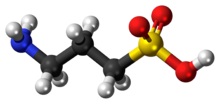Homotaurine

| |

| |
| Names | |
|---|---|
| IUPAC name
3-Aminopropane-1-sulfonic acid
| |
| Other names
Tramiprosate; Alzhemed; 3-APS
| |
| Identifiers | |
3D model (JSmol)
|
|
| ChEMBL | |
| ChemSpider | |
| ECHA InfoCard | 100.020.889 |
| KEGG | |
PubChem CID
|
|
CompTox Dashboard (EPA)
|
|
| |
| |
| Properties | |
| C3H9NO3S | |
| Molar mass | 139.17 g·mol−1 |
| Melting point | 293 °C (559 °F; 566 K) (decomposition) |
Except where otherwise noted, data are given for materials in their standard state (at 25 °C [77 °F], 100 kPa).
| |
Homotaurine (also known as tramiprosate (INN), 3-amino-1-propanesulfonic acid, or 3-APS) is a synthetic organic compound. It is analogous to taurine, but with an extra carbon in its chain. It has GABAergic activity, apparently by mimicking GABA, which it resembles.[2]
Homotaurine was investigated in a Phase III clinical trial as a potential treatment for Alzheimer's disease that did not show efficacy in its primary endpoints.[3]
Biochemical properties
In preclinical studies it had been found to bind to soluble amyloid beta and inhibit the formation of neurotoxic aggregates.[3][4] Homotaurine has also shown anticonvulsant activities, reduction in skeletal muscle tonus, and hypothermic activity.[5]
Homotaurine has been reported as a GABA antagonist,[2] as well as a GABA agonist.[5][6] In vitro studies have found that homotaurine is a GABAA partial agonist[7] as well as a GABAB receptor partial agonist with low efficacy, becoming an antagonist and a displacing full agonist of GABA or baclofen at this receptor.[8] In a study in rats, homotaurine reversed the catatonia induced by baclofen (the prototypical GABAB agonist),[9] and was able to produce analgesia via the GABAB receptor, an effect that was abolished when CGP 35348, a GABAB receptor antagonist was applied.[10][11]
One study in rats showed that homotaurine suppressed ethanol-stimulated dopamine release, as well as ethanol intake and preference in rats in a way similar to the N-acetyl derivative of homotaurine, acamprosate.[12] Acamprosate was approved by the FDA in 2004 to treat alcohol dependence.[2]
See also
- Acamprosate – a derivative of homotaurine
References
- ^ "Homotaurine". Sigma-Aldrich.
- ^ a b c Lednicer, Daniel (2008). The Organic Chemistry of Drug Synthesis (7th ed.). Hoboken: John Wiley & Sons. p. 15. ISBN 978-0-470-18066-2.
{{cite book}}: Unknown parameter|name-list-format=ignored (|name-list-style=suggested) (help) - ^ a b . doi:10.3275/8585.
{{cite journal}}: Cite journal requires|journal=(help); Missing or empty|title=(help) - ^ . doi:10.2174/156720507781788882.
{{cite journal}}: Cite journal requires|journal=(help); Missing or empty|title=(help) - ^ a b Oja SS and Kontro P. (2013). Lajtha ANS (ed.). Chapter 18: Taurine. Springer Science & Business Media. p. 520. ISBN 9781468443677.
{{cite book}}:|work=ignored (help) - ^ Armen H. Tashjian and Ehrin J. Armstrong. Principles of Pharmacology: The Pathophysiologic Basis of Drug Therapy. Edited by David E. Golan. Lippincott Williams & Wilkins, 2011 ISBN 9781451118056. Page 308
- ^ . doi:10.1007/s00726-014-1813-0.
{{cite journal}}: Cite journal requires|journal=(help); Missing or empty|title=(help) - ^ . doi:10.1111/j.1476-5381.1983.tb10529.x.
{{cite journal}}: Cite journal requires|journal=(help); Missing or empty|title=(help) - ^ . doi:10.1016/0028-3908(87)90108-0.
{{cite journal}}: Cite journal requires|journal=(help); Missing or empty|title=(help) - ^ . doi:10.1016/s0306-3623(97)00279-6.
{{cite journal}}: Cite journal requires|journal=(help); Missing or empty|title=(help) - ^ . doi:10.1046/j.1472-8206.2001.00026.x.
{{cite journal}}: Cite journal requires|journal=(help); Missing or empty|title=(help) - ^ . doi:10.1016/s0014-2999(02)01272-4.
{{cite journal}}: Cite journal requires|journal=(help); Missing or empty|title=(help)
